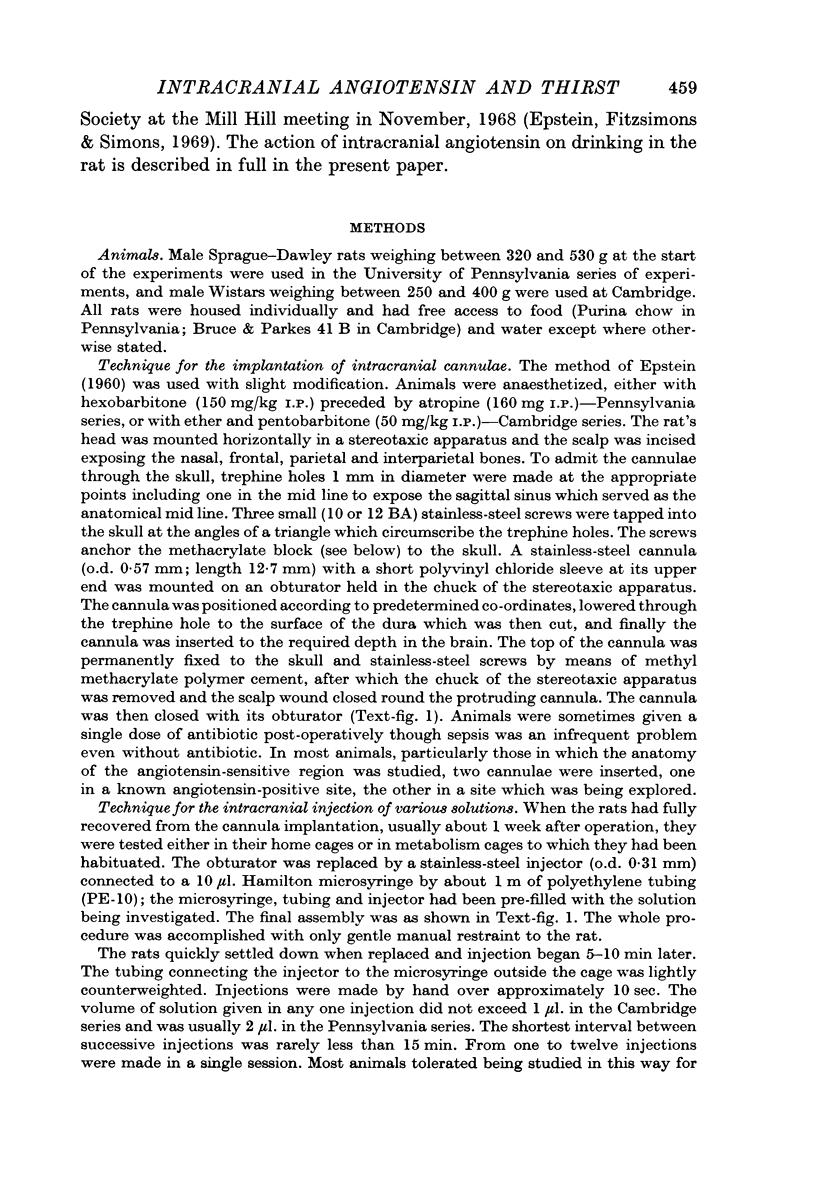Abstract
1. When applied directly to the brain, angiotensin II amide, as either the valine5 octapeptide, causes rats in normal fluid balance to drink water.
2. The drinking response to angiotensin injections is copious, rapid, repeatable within the same test session, and stable over months of testing in the same animal.
3. The response is motivationally potent and specific. After injection the animals move directly to the source of water and drink. There is typically no preliminary hyperactivity or subsequent depression. The animals do not eat, gnaw or exhibit other behaviours that are not normally seen during spontaneous drinking. The injections rouse sleeping animals to drink and interrupt eating in animals deprived of food for two days.
4. The region of the brain that is most sensitive to angiotensin includes the anterior hypothalamus, the preoptic region, and the septum including the nucleus accumbens.
5. Intracranial renin elicited drinking. Bradykinin and vasopressin did not, nor did adrenaline, noradrenaline or aldosterone. In the most sensitive region, sites positive for angiotensin also yielded drinking to carbachol.
6. Responses were obtained with 5 ng (ca. 5 p-mole) and occurred reliably with 50 ng angiotensin or more. The dose—response curve for amount drunk rose from 5 to 100 ng and levelled off thereafter. Angiotensin is therefore the most potent dipsogen known and is effective at doses that are reasonably within the concentration range for circulating endogenous angiotensin.
7. Injections into the sensitive region of doses of angiotensin that were effective for drinking did not produce peripheral haemodynamic changes in lightly anaesthetized rats.
8. This work strengthens the suggestion that angiotensin is a natural hormone of drinking behaviour that participates in extracellular thirst by its release from the kidney and subsequent direct action on a specific chemoreceptive region in the anterior diencephalon and limbic lobe.
Full text
PDF


















Images in this article
Selected References
These references are in PubMed. This may not be the complete list of references from this article.
- ANDERSSON B. The effect of injections of hypertonic NaCl-solutions into different parts of the hypothalamus of goats. Acta Physiol Scand. 1953;28(2-3):188–201. doi: 10.1111/j.1748-1716.1953.tb00969.x. [DOI] [PubMed] [Google Scholar]
- Blass E. M., Hanson D. G. Primary hyperdipsia in the rat following septal lesions. J Comp Physiol Psychol. 1970 Jan;70(1):87–93. doi: 10.1037/h0028385. [DOI] [PubMed] [Google Scholar]
- Booth D. A. Mechanism of action of norepinephrine in eliciting an eating response on injection into the rat hypothalamus. J Pharmacol Exp Ther. 1968 Apr;160(2):336–348. [PubMed] [Google Scholar]
- Brown J. J., Curtis J. R., Lever A. F., Robertson J. I., De Wardener H. E., Wing A. J. Plasma renin concentration and the control of blood pressure in patients on maintenance haemodialysis. Nephron. 1969;6(3):329–349. doi: 10.1159/000179737. [DOI] [PubMed] [Google Scholar]
- EPSTEIN A. N. Reciprocal changes in feeding behavior produced by intrahypothalamic chemical injections. Am J Physiol. 1960 Dec;199:969–974. doi: 10.1152/ajplegacy.1960.199.6.969. [DOI] [PubMed] [Google Scholar]
- FISHER A. E., COURY J. N. Cholinergic tracing of a central neural circuit underlying the thirst drive. Science. 1962 Nov 9;138(3541):691–693. doi: 10.1126/science.138.3541.691. [DOI] [PubMed] [Google Scholar]
- FITZSIMONS J. T. Drinking by rats depleted of body fluid without increase in osmotic pressure. J Physiol. 1961 Dec;159:297–309. doi: 10.1113/jphysiol.1961.sp006809. [DOI] [PMC free article] [PubMed] [Google Scholar]
- Fitzsimons J. T. La soif extracellulaire. Ann Nutr Aliment. 1968;22(4):131–144. [PubMed] [Google Scholar]
- Fitzsimons J. T., Simons B. J. The effect on drinking in the rat of intravenous infusion of angiotensin, given alone or in combination with other stimuli of thirst. J Physiol. 1969 Jul;203(1):45–57. doi: 10.1113/jphysiol.1969.sp008848. [DOI] [PMC free article] [PubMed] [Google Scholar]
- Fitzsimons J. T. The role of a renal thirst factor in drinking induced by extracellular stimuli. J Physiol. 1969 Apr;201(2):349–368. doi: 10.1113/jphysiol.1969.sp008760. [DOI] [PMC free article] [PubMed] [Google Scholar]
- Fitzsimons T. J., Le Magnen J. Eating as a regulatory control of drinking in the rat. J Comp Physiol Psychol. 1969 Mar;67(3):273–283. doi: 10.1037/h0026772. [DOI] [PubMed] [Google Scholar]
- GROSSMAN S. P. Eating or drinking elicited by direct adrenergic or cholinergic stimulation of hypothalamus. Science. 1960 Jul 29;132(3422):301–302. doi: 10.1126/science.132.3422.301. [DOI] [PubMed] [Google Scholar]
- Goodwin F. J., Kirshman J. D., Sealey J. E., Laragh J. H. Influence of the pituitary gland on sodium conservation, plasma renin and renin substrate concentrations in the rat. Endocrinology. 1970 Apr;86(4):824–834. doi: 10.1210/endo-86-4-824. [DOI] [PubMed] [Google Scholar]
- HARVEY J. A., HUNT H. F. EFFECT OF SEPTAL LESIONS ON THIRST IN THE RAT AS INDICATED BY WATER CONSUMPTION AND OPERANT RESPONDING FOR WATER REWARD. J Comp Physiol Psychol. 1965 Feb;59:49–56. doi: 10.1037/h0021600. [DOI] [PubMed] [Google Scholar]
- Joy M. D., Lowe R. D. Evidence for a medullary site of action in the cardiovascular response to angiotensin II. J Physiol. 1970 Feb;206(2):41P–42P. [PubMed] [Google Scholar]
- MILLER N. E., GOTTESMAN K. S., EMERY N. DOSE RESPONSE TO CARBACHOL AND NOREPINEPHRINE IN RAT HYPOTHALAMUS. Am J Physiol. 1964 Jun;206:1384–1388. doi: 10.1152/ajplegacy.1964.206.6.1384. [DOI] [PubMed] [Google Scholar]
- NAIRN R. C., MASSON G. M., CORCORAN A. C. The production of serous effusions in nephrectomised animals by the administration of renal extracts and renin. J Pathol Bacteriol. 1956 Jan;71(1):155–163. doi: 10.1002/path.1700710121. [DOI] [PubMed] [Google Scholar]
- Scroop G. C., Lowe R. D. Central pressor effect of angiotensin mediated by the parasympathetic nervous system. Nature. 1968 Dec 28;220(5174):1331–1332. doi: 10.1038/2201331a0. [DOI] [PubMed] [Google Scholar]
- Stricker E. M. Extracellular fluid volume and thirst. Am J Physiol. 1966 Jul;211(1):232–238. doi: 10.1152/ajplegacy.1966.211.1.232. [DOI] [PubMed] [Google Scholar]
- Vander A. J. Control of renin release. Physiol Rev. 1967 Jul;47(3):359–382. doi: 10.1152/physrev.1967.47.3.359. [DOI] [PubMed] [Google Scholar]



